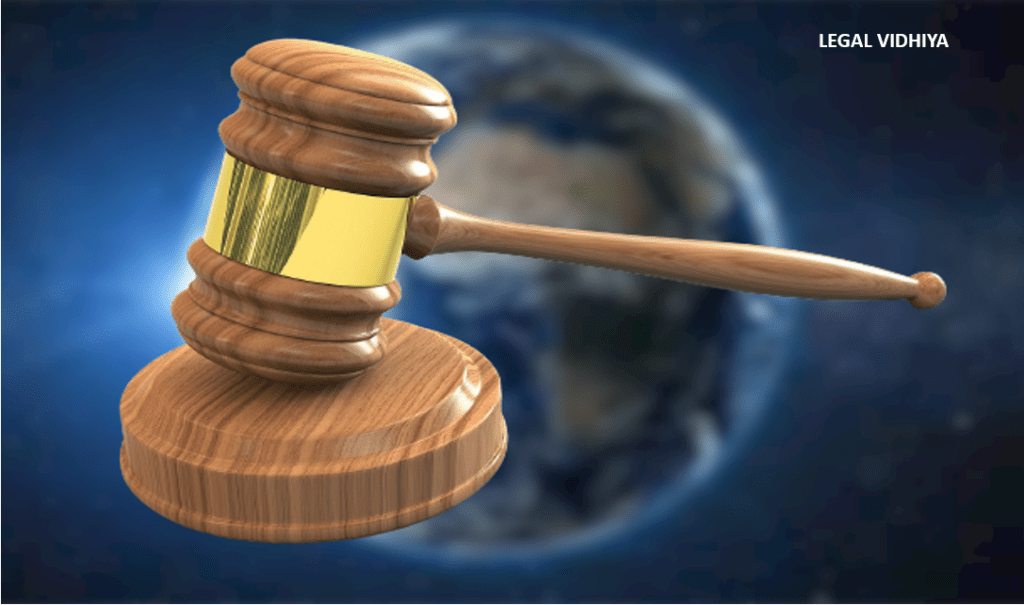
This Article is written by Megha Arora of 5th Semester of Department of Laws, Panjab University, an intern under Legal Vidhiya
ABSTRACT
This article delves into the intricate world of copyright law, elucidating its role in safeguarding the intellectual creations of authors, artists, and creators. It explores a tapestry of international treaties and conventions meticulously crafted over time to establish common ground for copyright protection on a global scale.
Beginning with the primary Berne Convention of 1886, the article traces the evolution of copyright treaties, from the Universal Copyright Convention of 1952 to the contemporary WIPO treaties of 1996. These agreements aim to harmonize copyright standards, ensuring creators receive due recognition and protection for their works, even in our digital age.
The article highlights the significance of treaties like the Rome Convention of 1961, addressing the rights of performers and producers, and the Beijing Treaty on Audiovisual Performances of 2012, bridging gaps in protection for audiovisual performers. It also underscores the humanitarian aspect of copyright through the Marrakesh Treaty of 2013, promoting access to knowledge for individuals with disabilities.
In essence, these international agreements underscore the enduring importance of copyright law in nurturing creativity, innovation, and accessibility while balancing the interests of creators and the broader public good on a global stage.
KEYWORDS
Copyright law, International Treaties, International Conventions, Berne Convention, WIPO Copyright Treaty, WIPO Performances and Phonograms Treaty, Rome Convention, Beijing Treaty, Marrakesh Treaty, Intellectual Property
INTRODUCTION
COPYRIGHT LAW
Copyright law is an intellectual property law which refers to the legal framework that grants exclusive rights to the creators of original works of authorship. These works can encompass a wide range of creative expressions, including literary, artistic, musical, and dramatic works, cinematograph film, sound recordings, and more. It provides creators with the legal protection and control over their intellectual creations. It grants exclusive rights to the authors and creators to determine how their works are used, reproduced, and distributed, performed publicly ensuring that they receive fair recognition and compensation for their efforts. And this right of author or creator over the copyright typically last for the lifetime of the creator plus a set number of years (it’s 60 year in India) after their death.
The law of Copyright strikes a balance between the interests of creators and the broader public interest in accessing and using creative works. It seeks to incentivize innovation and artistic expression while also allowing for the dissemination of knowledge and culture. This balance is further influenced by international treaties and conventions, which help harmonize copyright laws on a global scale.
INTERNATIONAL TREATIES AND CONVENTIONS RELATED TO COPYRIGHT
In our interconnected and digital world, the protection of intellectual property transcends national borders and has become a global concern. And that’s where international treaties and conventions come into play. International treaties and conventions related to copyright law serve as the cornerstone of a global framework for the protection of creative works. These legal agreements bring countries together over the world to establish common standards, rights, and obligations, ensuring that creators and their works receive consistent protection worldwide.
There are numerous international treaties and conventions have been established over a period of time to address the emerging issues related to copyright law. These international treaties and conventions related to copyright are discussed below:
- THE BERNE CONVENTION (1886)
The Berne Convention for the Protection of Literary and Artistic Works, was established in 1886 in Switzerland, is a pivotal milestone in the history of international copyright agreements. It is a foundational treaty for copyright protection which aimed to harmonize copyright laws among participating nations, ensuring that works of authors from member countries were protected in others. The Berne Convention introduced the concept that a copyright exists the moment a work is “fixed”, or manifested into a tangible format, rather than requiring registration.
ORIGIN AND HISTORICAL CONTEXT
The Berne Convention is one of the most oldest important international treaties in the realm of intellectual property and copyright law. The inspiration for the Berne Convention can be traced back to the Paris Convention for the Protection of Industrial Property in 1883. It was established in 1886 under the guidance of Victor Hugo’s Associated Literature Artist International association, introduced significant changes to international copyright protection.
EVOLUTION AND ADMINISTRATION OF BERNE CONVENTION
Since its inception in 1886, the Berne Convention has undergone multiple revisions and amendments, including those in Paris (1896), Berlin (1908), Berne (1914), Rome (1928), Brussels (1948), Stockholm (1967), and Paris (1971). It was also amended in 1979 to address evolving copyright issues and maintain its relevance in the modern era.[1]
The administration of the Berne Convention on Intellectual Property Law falls under the responsibility of the United Nations’ World Intellectual Property Organization (WIPO). This convention stands out as one of the most widely adopted international treaties globally, solidifying its paramount significance in the realm of intellectual property.
PURPOSE OF THE BERNE CONVENTION
One of its fundamental principles is that copyrights for creative works should be automatically enforced upon their creation, without the need for formal registration. In countries adhering to the Convention, authors are not required to assert or declare their copyright; it is granted as soon as their work is fixed in a tangible form, whether in writing or through recording.
Before the Berne Convention, copyright laws typically had jurisdiction solely over works created within a country’s borders. But the Convention ensures that foreign authors enjoy the same rights and privileges as local authors in any participating country.
BASIC PRINCIPLES OF THE CONVENTION
This convention is based upon three fundamental principles and incorporates various provisions to establish the minimum level of protection, along with offering special provisions that developing countries can utilize. These three core principles are as follows:
- Principle of National Treatment: It mandates that creative works originating in any of the Contracting States, such as works created by nationals of that State or first published there, must receive the same level of protection in all other Contracting States as those countries provide to their own citizens’ works.
- Principle of “Automatic” Protection: This principle emphasizes that copyright protection should not be subject to any formalities or conditions. Protection over copyright should be automatically granted upon the creation of the work.
- Principle of “Independence” of Protection: It asserts that copyright protection is independent of whether protection exists in the work’s country of origin. However, if a Contracting State offers a longer duration of protection than the minimum set by the Convention, and the work loses protection in its country of origin, the protection may be denied once it ceases in the country of origin.[2]
- UNIVERSAL COPYRIGHT CONVENTION, 1952
The Universal Copyright Convention (UCC) is an international treaty that was established to protect the rights of authors and creators of literary, artistic, and intellectual works. It was adopted by UNESCO (the United Nations Educational, Scientific and Cultural Organization) on September 6, 1952, and came into force on September 16, 1955. The UCC was created as an alternative to the Berne Convention for the Protection of Literary and Artistic Works, which some countries found too restrictive or outdated.
HISTORICAL BACKGROUND OF UNIVERSAL COPYRIGHT CONVENTION
The Universal Copyright Convention (UCC), established in 1952 under UNESCO, aimed to bridge the gap between various global legal systems and uphold copyright as a human right.
Before World War II, United States was legally isolated from countries that had signed the Berne Convention, an international agreement protecting literary and artistic works from piracy. Unlike these countries, the U.S. required authors to complete administrative formalities, like registering their work with the US Copyright Office, as a prerequisite for protection. This legal divergence prevented the United States from joining the Berne Convention, which recognized copyright upon creation. As a result, no legal mechanism existed for U.S. works to be protected in countries like Japan or Western Europe, nor for foreign works to be safeguarded in the United States without complying with American law.
Then, Universal Copyright Convention was established in 1952 under UNESCO’s guidance and provided a brilliant solution to this issue. It stipulated that if copies of a work from one contracting state displayed the © symbol, the copyright owner’s name, and the year of first publication, it would satisfy the formalities required by the national law of another contracting state. This streamlined cross-border protection.[3]
FEATURES OF UNIVERSAL COPYRIGHT CONVENTION
The key features of the Universal Copyright Convention (UCC) include:
- Equal Treatment: Signatory nations must not favor their domestic authors over those from other signatory nations. There is no specified minimum protection for either domestic or foreign authors.
- Copyright Notice: All copies of a work must display a formal copyright notice, consisting of the copyright symbol, the copyright owner’s name, and the year of first publication. Additional formalities may be required by a signatory nation, as long as they align with the requirements of other signatory nations.
- Copyright Term: Copyright protection in member nations must last for the life of the author plus 25 years, except for photographic works and works of applied art, which have a 10-year term.
- Translation Rights: All adhering nations must grant an exclusive right of translation for seven years, with the possibility of compulsory licensing under specific circumstances for the remainder of the copyright term.
- Protection for Photographic and Applied Art: Works of photographic art and works of applied art are protected for a term of ten years.
These features collectively define the principles and requirements of the UCC in relation to copyright protection and international collaboration.[4]
- WORLD INTELLECTUAL PROPERTY ORGANIZATION COPYRIGHT TREATY (1996)
The WIPO Copyright Treaty (WCT) is a specialized agreement connected to the Berne Convention, focusing on safeguarding digital works and the rights of their creators. It mandates that any Contracting Party, even if not bound by the Berne Convention, must adhere to the substantive provisions of the 1971 (Paris) Act of the Berne Convention.
The WCT Identifies two key subjects eligible for copyright protection:
- computer programs, irrespective of their form,
- and compilations of data or other materials (referred to as “databases”) that, due to their selection or arrangement, demonstrate intellectual creativity. And any database lacking this creative element fall outside the treaty’s scope.
Regarding authors’ rights, in addition to those recognized by the Berne Convention, the WCT grants the certain rights to authors:
- The Right Of Distribution: This right allows the authorization of public access to original works and copies through sale or transfer of ownership.
- The Right Of Rental: This right permits commercial rental of original works and copies of certain kinds of works, like computer programs, cinematographic works, and works embodied in phonograms, depending on national law.
- The Right Of Communication: The right of communication to the public, authorizes any form of public communication via wire or wireless means, including on-demand, interactive communication through the Internet.
The minimum term of protection for any type of work under the WCT is 50 years.
The treaty emphasizes that the exercise of rights should not be subject to formalities. It obliges Contracting Parties to establish legal remedies against the circumvention of technological protection measures and the alteration or removal of rights management information. Each Contracting Party must adopt measures compatible with its legal system to enforce the treaty. The Treaty establishes an Assembly of the Contracting Parties responsible for addressing treaty-related matters and entrusts WIPO’s Secretariat with administrative tasks.
The WCT was concluded in 1996 and became effective in 2002. It’s open to WIPO member states, the European Community, and may admit other intergovernmental organizations upon decision by the Assembly.[5]
- WORLD INTELLECTUAL PROPERTY ORGANIZATION PERFORMANCES AND PHONOGRAMS TREATY (1996)
The World Intellectual Property Organization Performances and Phonograms Treaty (WPPT), established in 1996, serves as an international agreement under the umbrella of the World Intellectual Property Organization (WIPO). It plays a pivotal role in complementing existing international copyright treaties, notably the Berne Convention for the protection of performers, producers of phonograms, and broadcasting organizations. The WPPT’s core mission is to keep pace with the constantly changing dynamics of the global marketplace, technological advancements, and the diverse forms of creative works being produced. It recognizes the need for modernization in copyright treaties and regulations to accommodate the evolving methods of distribution, types of works, and patterns of use, all of which have been greatly influenced by digital innovation.
The WPPT, often referred to as one of the “Internet Treaties,” was created to address the challenges posed by the rapid evolution of digital technology and communication channels, particularly in the context of distributing digitally protected works over the Internet. As technology transformed the way copyrighted content was created, distributed, and consumed, the WPPT aimed to adapt existing intellectual property regulations to this digital landscape.
One of the significant outcomes of this international treaty’s implementation in the United States is the Digital Millennium Copyright Act (DMCA). The DMCA is a comprehensive piece of legislation that encompasses various aspects of copyright law in the digital age, aligning itself with the principles laid out in the WPPT.
The adoption of the WPPT in December, 1996 marked a significant milestone in the field of intellectual property rights. It brought together a consensus of 100 member states of the European Union (EU) in Geneva, Switzerland. At that time, both the Berne Convention and the Rome Convention had not undergone substantial modifications for a quarter of a century. This emphasized the urgent need for a treaty like the WPPT to bridge the gap between traditional copyright principles and the digital era’s realities.
In summary, the World Intellectual Property Organization Performances and Phonograms Treaty (WPPT) is a crucial international agreement designed to address the challenges posed by the digital age in the realm of intellectual property rights. By updating and complementing existing copyright treaties, the WPPT seeks to ensure that creative works remain protected and that the rights of creators, performers, and phonogram producers are upheld in the rapidly evolving digital landscape. Its adoption in 1996 marked a turning point in international copyright law, reflecting the global community’s commitment to safeguarding intellectual property rights in the face of technological innovation.[6]
- INTERNATIONAL CONVENTION FOR THE PROTECTION OF PERFORMERS, PRODUCERS OF PHONOGRAMS AND BROADCASTING ORGANIZATIONS, 1961
ORIGIN AND PURPOSE
The Rome Convention, also known as the International Convention for the Protection of Performers, Producers of Phonograms, and Broadcasting Organizations, came into existence in 1961. Its origins trace back to discussions during the 1928 Rome diplomatic conference, which aimed to revise the Berne Convention. However, the convention’s final draft was formulated in 1960 during a meeting held in The Hague, Netherlands, where experts from UNESCO, the International Labour Office (ILO), and the United International Bureau for the Protection of Intellectual Property collaborated to create it.
PROTECTION GRANTED TO THE ENTITIES UNDER THE CONVENTIONTION
This international treaty serves to safeguard the rights of three key entities in the creative and entertainment industries: performers, producers of phonograms, and broadcasting organizations. It addresses various aspects of their intellectual property and rights.
- Protection to Performers: Rome Convention extends protection to performers, which includes actors, singers, musicians, dancers, and those who perform literary or artistic works. It shields them from certain unauthorized acts, such as the broadcast and public communication of live performances, the fixation of live performances, and the reproduction of fixations without their consent or for purposes different from the initially given consent.
- Protection to Producers: Under the convention, producers of phonograms are also granted the right to authorize or prohibit the direct or indirect reproduction of their phonograms. “Phonograms” in this context refer to exclusively aural recordings of sounds from performances or other sounds. When a phonogram published for commercial purposes leads to secondary uses like broadcasting, a single equitable remuneration must be paid to performers, producers of phonograms, or both. However, contracting states have the flexibility to not apply this rule or limit its application.
- Protection to Broadcasting Organizations: The broadcasting organizations are empowered to authorize or prohibit specific acts, such as rebroadcasting, fixation, reproduction of fixations, and communication to the public of their television broadcasts, particularly in places accessible to the public with an entrance fee.
DURATION OF PROTECTION
Regarding the duration of protection, it must endure for a minimum of 20 years, calculated from the end of the year in which the fixation was made for phonograms and performances incorporated therein, or from the year the performance took place for performances not incorporated in phonograms, or from the year of the broadcast. However, many national laws now extend this term to 50 years, especially for phonograms and performances.
Thus, the Rome Convention plays a crucial role in harmonizing and protecting the intellectual property rights of performers, phonogram producers, and broadcasting organizations on an international scale.[7]
- BEIJING TREATY ON AUDIO-VISUAL PERFORMANCE, 2012
The Beijing Treaty on Audiovisual Performances was established during the Diplomatic Conference on the Protection of Audiovisual Performances held in Beijing from June 20 to 26, 2012. This treaty focuses on safeguarding the intellectual property rights of performers involved in audiovisual productions.
The WIPO Beijing Treaty on Audiovisual Performances (BTAP) is a significant international agreement established in 2012. It marks a historic moment by recognizing the intellectual property rights of performers in their audiovisual presentations. This treaty addresses a long-standing issue that dates back to the 1960s, where only audio performances were protected in most countries.
FIA, a non-governmental organization with observer status at WIPO, played a crucial role in fostering cooperation among governments and promoting a consensus on safeguarding audiovisual performances. The BTAP rectifies the previous discrimination by acknowledging that all performances, regardless of their delivery method or whether they are audio or audiovisual, deserve intellectual property protection.[8]
RIGHTS GRANTED BY BEIJING TREATY
- The WIPO Beijing Treaty on Audiovisual Performances (BTAP) bestows performers with four distinct economic rights for their performances captured in audiovisual formats like movies. These include:
- The right of reproduction.
- The right of distribution.
- The right of rental.
- The right of making available.
- For unfixed or live performances, the treaty grants performers three economic rights:
- The right of broadcasting (excluding rebroadcasting).
- The right of communication to the public (excluding broadcast performances).
- The right of fixation.
- The BTAP also ensures performers’ moral rights, which entail the right to be recognized as the performer (unless circumstances dictate otherwise due to the manner of use) and the right to object to any changes or alterations that could harm their reputation, taking into consideration the nature of the audiovisual recordings.
- The treaty also establishes that performers have the authority to permit the broadcasting and public communication of their performances captured in audiovisual recordings.[9]
- THE MARRAKESH TREATY, 2013
The Marrakesh Treaty, which aims to make it easier for individuals who are blind, visually impaired, or have other print disabilities to access published works, is a relatively new inclusion among the international copyright agreements managed by WIPO (the World Intellectual Property Organization). It was adopted in Marrakesh on June 27, 2013, with a strong focus on humanitarian and social development goals. The primary aim of the MVT is to establish mandatory exceptions and limitations to copyright rules, benefiting individuals who are blind, visually impaired, or otherwise unable to access printed materials.
The treaty mandates that member countries introduce a standardized set of exceptions and limitations to copyright laws. These provisions enable the reproduction, distribution, and availability of published works in formats accessible to individuals with disabilities. It also permits the cross-border exchange of these adapted works by organizations serving these beneficiaries.
The treaty will bring forth four main benefits.
- Policy Advocacy and Awareness
- Encourages discussions and raises awareness about policies benefiting persons with disabilities.
- Emphasizes that policy planning and implementation are crucial for the treaty’s effectiveness.
- Promotes the involvement of the disabled community in shaping these policies.
- Benefitting Vulnerable Communities
- Provides vital support to one of the most vulnerable sections of society.
- Increases opportunities for education, playing a transformative role in a globalized world.
- Highlights the need for educational institutions to offer accessible formats for the print disabled.
- Enhanced Social Integration and Cultural Participation
- Facilitates social integration and cultural participation for the visually impaired.
- Promotes inclusion by granting equal access to knowledge and information.
- Encourages the dissemination of local culture through accessible leisure materials.
- Support for Poverty Alleviation and Economic Development
- Supports poverty alleviation programs by empowering individuals with disabilities.
- Enhances individual capabilities, fostering professional growth and self-sufficiency.
- Enables disabled individuals to contribute significantly to local economies and national development.
- Strengthens human capital and aligns with the goals of international institutions.[10]
CONCLUSION
In conclusion, the world of copyright law is a multifaceted and dynamic arena that serves as the backbone of protecting and nurturing creativity and innovation across the globe. At its core, copyright law provides a vital framework that empowers creators by granting them exclusive rights over their intellectual creations.
To ensure that these rights are recognized and upheld on an international scale, a web of carefully crafted international treaties and conventions has been established over the years. These agreements bridge the gaps between nations, harmonizing copyright standards and creating a common understanding of the principles that underpin the protection of creative works.
From the foundational Berne Convention of 1886, which revolutionized copyright protection by introducing the notion of automatic rights upon creation, to the more recent treaties like the WIPO Copyright Treaty and Performances and Phonograms Treaty of 1996, The Beijing Treaty on Audiovisual Performances of 2012, The Marrakesh Treaty of 2013 every treaty is designed to tackle the challenges of the digital age and each treaty has played a pivotal role in shaping the global copyright landscape.
Collectively, these international agreements exemplify the global commitment to striking a delicate balance between protecting the rights of creators and promoting the broader public interest. They recognize the value of creativity while ensuring that knowledge and culture can be disseminated and shared. In essence, these treaties stand as a testament to the enduring relevance and adaptability of copyright law in our ever-evolving world, where creativity, innovation, and accessibility remain paramount.
REFERENCES
- WIPO, https://www.wipo.int/copyright/en/ , (Sept. 10, 2023).
- Anamta Khan, Berne Convention, IP MATTERS (Sept. 8 2023), https://www.theipmatters.com/post/berne-convention.
- What is Beijing Treaty, BEIJING TREATY, https://beijingtreaty.com/about/what-is-the-beijing-treaty/ , (Sept. 9, 2023).
- UNESCO, https://en.unesco.org/courier/news-views-online/universal-copyright-convention, (Sept. 9, 2023).
- The Editors of Encyclopaedia Britannica, Universal Copyright Convention, BRITANNICA (Sept. 8, 2023, 2:18 p.m.), https://www.britannica.com/topic/Universal-Copyright-Convention.
- Margaret Rouse, WIPO Performances and Phonograms Treaty, TECHOPEDIA (Sept. 9, 2023), https://www.techopedia.com/definition/28161/wipo-performances-and-phonograms-treaty-wppt.
- Shubhangi Sharma, Intellectual Property Rights: An overview of leading organizations and conventions, IPLEADERS (Sept. 9, 2023), https://blog.ipleaders.in/leading-international-instruments-related-to-intellectual-property-rights/.
[1] Anamta Khan, Berne Convention, IP MATTERS (Sept. 8 2023), https://www.theipmatters.com/post/berne-convention.
[2] WIPO, https://www.wipo.int/treaties/en/ip/berne/summary_berne.html#_ftn3, (Sept 7, 2023)
[3] UNESCO, https://en.unesco.org/courier/news-views-online/universal-copyright-convention, (Sept. 9, 2023).
[4] The Editors of Encyclopaedia Britannica, Universal Copyright Convention, BRITANNICA (Sept. 8, 2023, 2:18 p.m.), https://www.britannica.com/topic/Universal-Copyright-Convention.
[5] WIPO, https://www.wipo.int/treaties/en/ip/wct/summary_wct.html, (Sept 9, 2023).
[6] Margaret Rouse, WIPO Performances and Phonograms Treaty, TECHOPEDIA (Sept. 9, 2023), https://www.techopedia.com/definition/28161/wipo-performances-and-phonograms-treaty-wppt.
[7] WIPO, https://www.wipo.int/treaties/en/ip/wppt/summary_wppt.html, (Sept. 10, 2023)
[8] What is Beijing Treaty, BEIJING TREATY, https://beijingtreaty.com/about/what-is-the-beijing-treaty/, (Sept. 9, 2023).
[9] WIPO, https://www.wipo.int/treaties/en/ip/beijing/summary_beijing.html, (Sept. 8, 2023)
[10] WIPO, https://www.wipo.int/treaties/en/ip/marrakesh/summary_marrakesh.html, (Sept, 10, 2023).




0 Comments